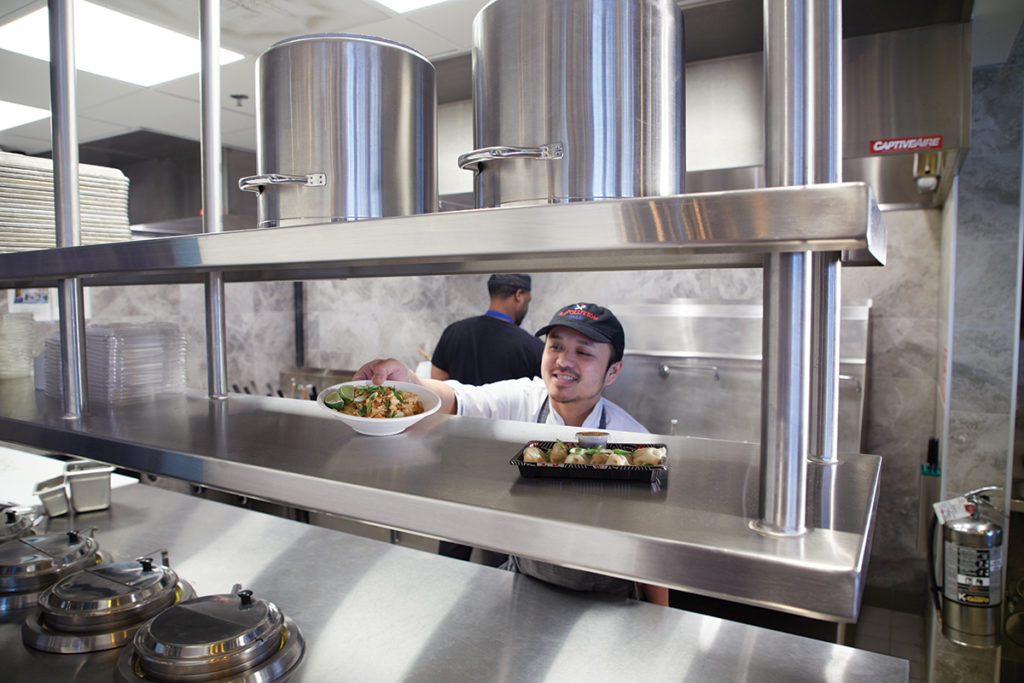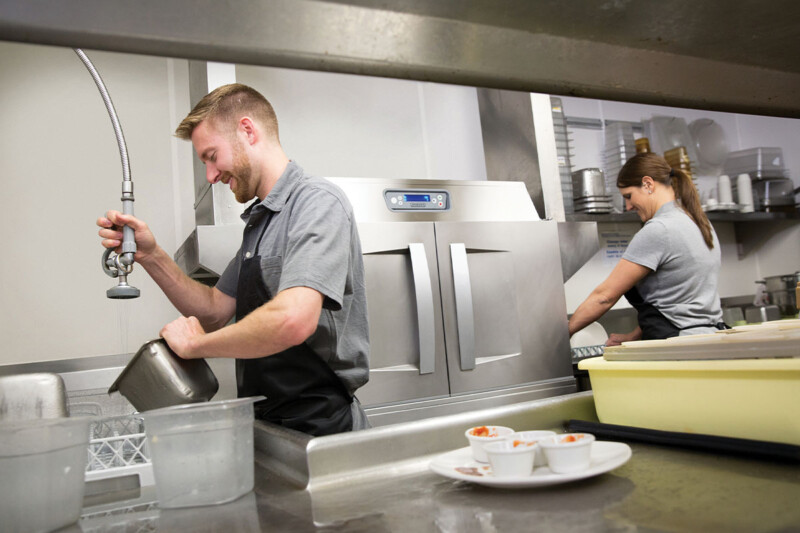How, When and Why to Spec Custom Fabrication in Your Kitchen

Look up fabricate in the dictionary, and you’ll come across definition like “invent,” “create,” “construct,” “build,” “manufacture,” “produce” and “make up.” When it comes to communication, fabrication is at best a good story and at worst intentional deception. But as far as your kitchens are concerned, fabrication is a must.
In the back of the house, you count on fabricators to provide you with sturdy, durable worktables, prep sinks, hand sinks, shelves, panels, backsplashes, dish tables, and much more. And you can buy many of those types of products out of a manufacturer’s or fabricator’s catalog. These off-the-shelf products come in a wide range of sizes, making it relatively simple and cost-effective to outfit a foodservice kitchen with basic needs.
Custom fabrication provides a number of benefits that not only can justify higher upfront costs in terms of value, but also provide a pretty quick payback on the premium you might pay. And many large fabricators offer what can be a happy medium between off-the-shelf products and an all-custom kitchen—stock products with add-ons or drop-ins such as a prep table with hand sink, or a worktable with shelves.
While typically more expensive, custom products sometimes can be less expensive than the combined cost of three or four stock products they replace. And if you have multiple units where the custom piece will be used, costs will likely quickly come down on a per-unit basis compared to a one-off.
You have a lot of choices, so when does it makes sense to spec custom fabrication, and how do you vet a good supplier? First, it helps to understand the three basic reasons why you’d want custom-fabricated products or equipment—fit, function and form.
Fit. Whether you’re building a new unit from scratch, building out an existing space or remodeling, there are a couple of reasons you might want the bespoke fit of custom fabrication.
“Real estate, or lack thereof, is the largest cost of any operation,” says Robert Doland, FCSI, Jacobs Doland Beer, New York. “To be able to fit that space with just the right amount of what you need is a big benefit.” Counters or worktables can extend all the way to walls without conforming to the nearest 12 in. or leaving gaps. That’s more space for landing dirty dishes, salad prep or countertop equipment.
Just as important is sanitation. “Equipment that’s fabricated to better fit the space is easier to keep clean and sanitary,” says Eric Weiss, President and CEO, elite | studio e, Farmingdale, N.Y. Seamless construction means no gaps or crevices for food to get in, and is safer for employees, too.
Function. Depending on both your menu and your production flow, you may require a specific layout or equipment in a certain spot to achieve operational goals. You may want a recessed hand sink built into a prep table, for example, to make employees at that station more efficient.
“Being able to customize ensures the efficiency of a particular work flow,” says Doland, “and also provides for everything that’s needed for the task without having to run back to a storeroom or adjacent prep station. Having everything needed on hand and in its place is worth far more over time than the initial cost of fabrication.”
One fabricator cites a client with a chain of movie theaters that offers a full-service menu during showings. Dirty dishes come into the kitchen all at once at the end of a movie. Designers specified a larger than normal landing table in the dishroom to handle the load. Another manufacturer noted that refrigerated chefs’ tables are a commonly custom ordered piece.
The advantage of a custom piece, as opposed to simply cutting a hole in a stock table and dropping in a sink, is that it will be all of one piece with no flanges and no caulk. That’s both safer and more sanitary.
Custom pieces specifically designed for a task or station also tend to be structurally stronger than combined stock pieces. “Fabricators can design fortification into certain areas,” Doland says, “which helps them stay useful longer than standardized items.”
Form. While function takes precedence when fabricating custom items, form sometimes comes to the fore once the function solution is found. Open kitchens, chef’s tables, serving lines that back up to the kitchen, essentially any prep, cooking or service area visible to your customers is ripe for customization. The point being that you want equipment to look as good as it performs.
Good fabricators can produce practically any creative project your designers can dream up, and many have both design and engineering staff to make sure the end product truly is as functional as it is beautiful to look at.
While back-of-house fabricators work primarily with stainless (and other metals), customizing the look often means working with other materials. One major fabricator is known for butcher-block tops, for example, and many of the larger manufacturers are accustomed to fabricating for the front of the house, too, which means using everything from glass to quartz, marble, laminates and surfaces like Corian in addition to wood.
Where To Start
Practically any shop with a welding torch and a shear/break machine can call themselves a fabricator, so the vetting process is important in weeding out those businesses from ones that understand foodservice and have the capabilities you need. To get the ball rolling, talk to your channel partners—consultants and dealers—and peers in the industry. Ask them who they recommend (or who they don’t), and what their experiences were like.
Then do some digging into the companies you think might be a good fit. Here are some of the areas to explore with companies that you’re considering.
Single or multiple sourcing. “In any large kitchen,” says one large custom fabricator, “there’s always a mix of standard out-of-the-catalog equipment and custom fabrication. Being able to offer both saves money down the road. All equipment is riding on one truck, and you’re coordinating delivery from one person.”
Sourcing from multiple companies isn’t unusual, however. You may prefer custom work from one company, shelving from another, and most other fabrication from a third. What you need and what you can get from any one supplier will dictate your choice.
Capabilities. Unlike a small shop with, say, welding and shearing capability, large fabricators have the equipment and staff to form and build a wide variety of products. Computer-controlled laser or water jets, press brakes, stamping machines and more provide precision cutting, bending, forming and assembly.
“A custom stainless fabricator/manufacturer should have a good working knowledge of the flow in a commercial kitchen,” says another large custom fabricator. “Understanding how the food moves through a kitchen and how equipment is used will help ensure that fabricated pieces work for their intended purposes.”
Ask if they have the engineering and/or design staff to solve problems. “Find out as much as you can about their engineering department,” says Doland. “Do they have smart people who can solve problems and create new solutions? Are their drawings technically accurate, and do they follow them when it’s time to build?”
Materials. If form is as important as function, look for a fabricator with experience in a variety of materials, or at least the materials you plan to use, not just stainless.
Certification. Fabricators should have NSF and UL or other third-party approvals for the products they make, including custom-fabricated items. If the items are complex, like refrigerated prep tables, pick a fabricator with both expertise and credentials, such as ASHRAE membership, in that area.
Location. A large fabricator with national coverage may be right for you if you’re building units across the country, but you may pay a lot for shipping if those units aren’t close to the manufacturer’s plant. Sometimes, using local or regional fabricators is a better strategy.
“One of the local fabricators is very good,” says Mark Cipriani, V.P., Dubick Fixture & Supply, a dealership in Cleveland, Ohio. “He’s been doing this for 30 years, so he can measure job sites when bidding and again when the walls are up so the fit is perfect.”
Lead times. Ask what kind of lead time the fabricator typically needs for custom projects, and what percentage of custom jobs are delivered on time. You’ll need to know the timing and ongoing fabrication status to properly manage your construction projects.
“Since field dimensions are usually required to make sure items fit correctly,” Doland says, “fabrication can’t start until the walls are in place. Then starts the build clock, which can be anywhere from two to 12 weeks depending on the complexity of the item.”
Four to six weeks is typically what a job should take, especially if the fabricator is replicating the same custom pieces. “The first time we build a custom unit,” says a custom fabricator, “the lead time may be six weeks. However, we can store the design of a piece on our server, and can replicate that piece much faster the second time, often cutting lead time in half.”
Experience. Find out how much experience the company has in your segment of the industry. Some fabricators specialize in big jobs like stadiums, while you may be looking for something different. Ask to see their work for similar clients.
Installation. “The best situation,” Weiss says, “is to have the manufacturer install what they build. Some don’t have that capability and want dealers to contract with local installers.” No matter who installs the equipment, make sure the fabricator has staff to troubleshoot any installation problems.
References. Ask people you know in the industry who they would use. Check with the fabricator’s references and ask them what kind of experiences they’ve had with the company you’re considering.
Industry affiliations. Fabricators that belong to or support industry associations such as NAFEM, FCSI, and others, are likely to be more experienced and responsive to your needs than a shop that doesn’t cater primarily to foodservice clients.
Credit report. You should also do a credit check on your suppliers and/or talk to the Better Business Bureau to find out if the company is not only on the up-and-up, but whether it’s in healthy enough financial shape to handle your orders.
By doing your homework, you’ll find a partner who can fabricate a little magic in your kitchens.
RELATED CONTENT
- Advertisement -
- Advertisement -
- Advertisement -
TRENDING NOW
- Advertisement -
- Advertisement -
- Advertisement -


